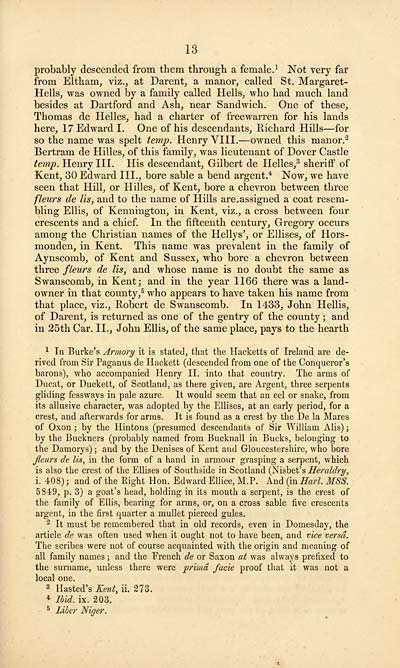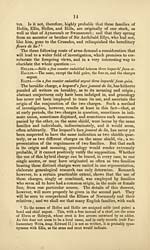Notices of the Ellises of England, Scotland, and Ireland, from the conquest to the present time
(29) Page 13
Download files
Complete book:
Individual page:
Thumbnail gallery: Grid view | List view

13
probably descended from them through a female. 1 Not very far
from Eltham, viz., at Darent, a manor, called St. Margaret-
Hells, was owned by a family called Hells, who had much land
besides at Dartford and Ash, near Sandwich. One of these,
Thomas de Helles, had a charter of freewarren for his lands
here, 17 Edward I. One of his descendants, Richard Hills — for
so the name was spelt temp. Henry VIII. — owned this manor. 3
Bertram de Hilles, of this family, was lieutenant of Dover Castle
temp. Henry III. His descendant, Gilbert de Helles, 3 sheriff of
Kent, 30 Edward III., bore sable a bend argent. 4 Now, we have
seen that Hill, or Hilles, of Kent, bore a chevron between three
fleurs de lis, and to the name of Hills are, assigned a coat resem-
bling Ellis, of Kennington, in Kent, viz., a cross between four
crescents and a chief. In the fifteenth century, Gregory occurs
among the Christian names of the Hellys', or Ellises, of Hors-
monden, in Kent. This name was prevalent in the family of
Aynscomb, of Kent and Sussex, who bore a chevron between
three fleurs de Us, and whose name is no doubt the same as
Swanscomb, in Kent; and in the year 1166 there was a land-
owner in that county, 5 who appears to have taken his name from
that place, viz., Robert de Swanscomb. In 1433, John Hellis,
of Darent, is returned as one of the gentry of the county ; and
in 25th Car. II., John Ellis, of the same place, pays to the hearth
1 In Burke's Armory it is stated, that the Hacketts of Ireland are de-
rived from Sir Paganus de Hackett (descended from one of the Conqueror's
barons), who accompanied Henry II. into that country. The arms of
Ducat, or Duckett, of Scotland, as there given, are Argent, three serpents
gliding fessways in pale azure. It would seem that an eel or snake, from
its allusive character, was adopted by the Ellises, at an early period, for a
crest, and afterwards for arms. It is found as a crest by the De la Mares
of Oxon ; by the Hintons (presumed descendants of Sir William Alis) ;
by the Buckners (probably named from Bucknall in Bucks, belonging to
the Damorys) ; and by the Denises of Kent and Gloucestershire, who bore
fleurs de lis, in the form of a hand in armour grasping a serpent, which
is also the crest of the Ellises of Southside in Scotland (Nisbet's Heraldry,
i. 408) ; and of the Right Hon. Edward Ellice, M.P. And (in Harl. MSS.
5849, p. 3) a goat's head, holding in its mouth a serpent, is the crest of
the family of Ellis, bearing for arms, or, on a cross sable five crescents
argent, in the first quarter a mullet pierced gules.
2 It must be remembered that in old records, even in Domesday, the
article de was often used when it ought not to have been, and vice versa.
The scribes were not of course acquainted with the origin and meaning of
all family names ; and the French de or Saxon at was always prefixed to
the surname, unless there were prima facie proof that it was not a
local one.
3 Hasted's Kent, ii. 273.
4 Ibid. ix. 203.
5 Liber Niger.
probably descended from them through a female. 1 Not very far
from Eltham, viz., at Darent, a manor, called St. Margaret-
Hells, was owned by a family called Hells, who had much land
besides at Dartford and Ash, near Sandwich. One of these,
Thomas de Helles, had a charter of freewarren for his lands
here, 17 Edward I. One of his descendants, Richard Hills — for
so the name was spelt temp. Henry VIII. — owned this manor. 3
Bertram de Hilles, of this family, was lieutenant of Dover Castle
temp. Henry III. His descendant, Gilbert de Helles, 3 sheriff of
Kent, 30 Edward III., bore sable a bend argent. 4 Now, we have
seen that Hill, or Hilles, of Kent, bore a chevron between three
fleurs de lis, and to the name of Hills are, assigned a coat resem-
bling Ellis, of Kennington, in Kent, viz., a cross between four
crescents and a chief. In the fifteenth century, Gregory occurs
among the Christian names of the Hellys', or Ellises, of Hors-
monden, in Kent. This name was prevalent in the family of
Aynscomb, of Kent and Sussex, who bore a chevron between
three fleurs de Us, and whose name is no doubt the same as
Swanscomb, in Kent; and in the year 1166 there was a land-
owner in that county, 5 who appears to have taken his name from
that place, viz., Robert de Swanscomb. In 1433, John Hellis,
of Darent, is returned as one of the gentry of the county ; and
in 25th Car. II., John Ellis, of the same place, pays to the hearth
1 In Burke's Armory it is stated, that the Hacketts of Ireland are de-
rived from Sir Paganus de Hackett (descended from one of the Conqueror's
barons), who accompanied Henry II. into that country. The arms of
Ducat, or Duckett, of Scotland, as there given, are Argent, three serpents
gliding fessways in pale azure. It would seem that an eel or snake, from
its allusive character, was adopted by the Ellises, at an early period, for a
crest, and afterwards for arms. It is found as a crest by the De la Mares
of Oxon ; by the Hintons (presumed descendants of Sir William Alis) ;
by the Buckners (probably named from Bucknall in Bucks, belonging to
the Damorys) ; and by the Denises of Kent and Gloucestershire, who bore
fleurs de lis, in the form of a hand in armour grasping a serpent, which
is also the crest of the Ellises of Southside in Scotland (Nisbet's Heraldry,
i. 408) ; and of the Right Hon. Edward Ellice, M.P. And (in Harl. MSS.
5849, p. 3) a goat's head, holding in its mouth a serpent, is the crest of
the family of Ellis, bearing for arms, or, on a cross sable five crescents
argent, in the first quarter a mullet pierced gules.
2 It must be remembered that in old records, even in Domesday, the
article de was often used when it ought not to have been, and vice versa.
The scribes were not of course acquainted with the origin and meaning of
all family names ; and the French de or Saxon at was always prefixed to
the surname, unless there were prima facie proof that it was not a
local one.
3 Hasted's Kent, ii. 273.
4 Ibid. ix. 203.
5 Liber Niger.
Set display mode to:
![]() Universal Viewer |
Universal Viewer | ![]() Mirador |
Large image | Transcription
Mirador |
Large image | Transcription
Images and transcriptions on this page, including medium image downloads, may be used under the Creative Commons Attribution 4.0 International Licence unless otherwise stated. ![]()
| Histories of Scottish families > Notices of the Ellises of England, Scotland, and Ireland, from the conquest to the present time > (29) Page 13 |
|---|
| Permanent URL | https://digital.nls.uk/95545961 |
|---|
| Description | A selection of almost 400 printed items relating to the history of Scottish families, mostly dating from the 19th and early 20th centuries. Includes memoirs, genealogies and clan histories, with a few produced by emigrant families. The earliest family history goes back to AD 916. |
|---|

